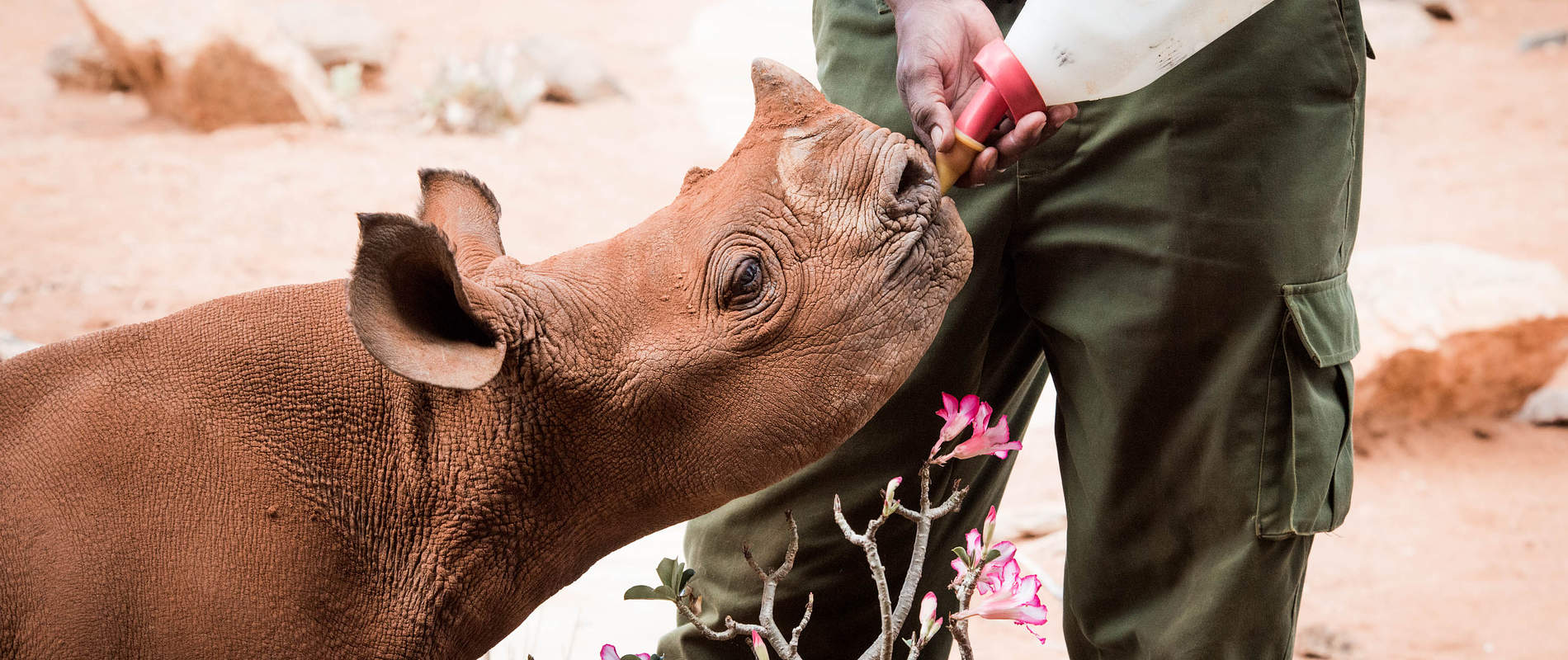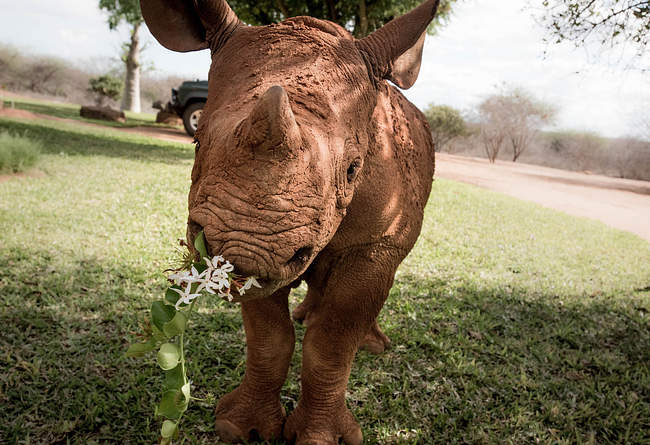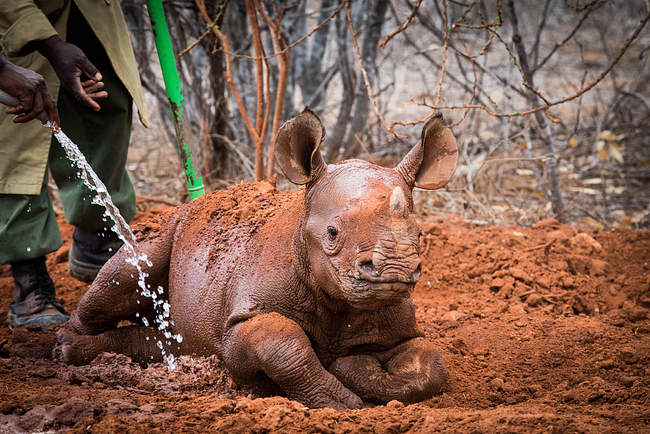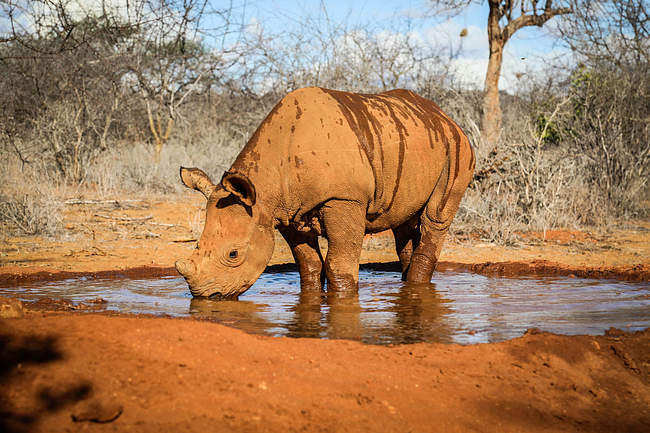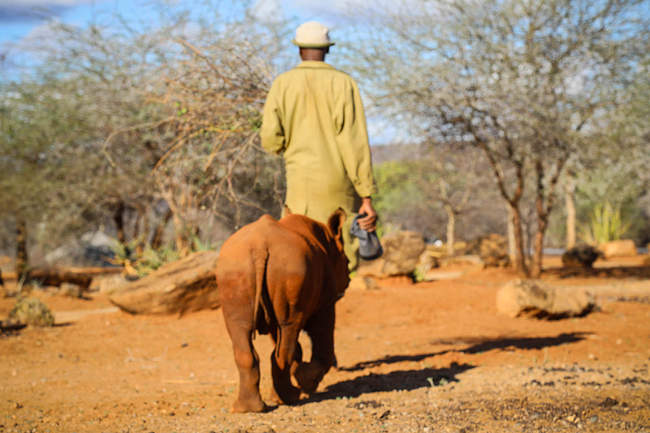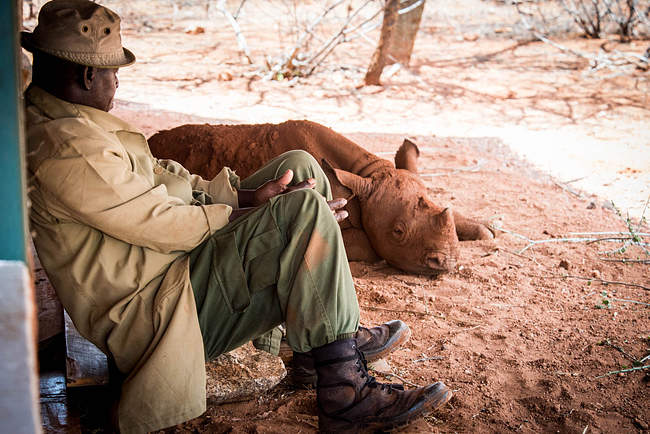Apollo is a black rhino orphan who was spotted standing beside his dead mother on 21st September 2019 . Vulnerable to predation and still milk dependent, a rescue was mounted and the calf was brought to the SWT's Kaluku Field HQ where he is currently being raised.
It all began with a routine aerial patrol together with the SWT’s Canine Unit, landing and checking out old poachers' hideouts. They were patrolling difficult-to-access water spring sites along the Yatta Plateau as well, looking for any sign of poaching activity, when pilot Andy Payne received an emergency call from the Kenya Wildlife Service (KWS). The Senior Warden of Tsavo West National Park requested that the helicopter urgently assist in rescuing a young rhino calf which had just been spotted standing beside its dead mother by Tsavo Trust Super Cub pilot Nick Trent. The young calf needed to be rescued by ground teams before it was disturbed and fled too far from its mother. The Veterinary Unit would also be called upon to access the carcass and determine the cause of death.
KWS and Tsavo Trust had assembled four ground teams on site near Ndawe in the IPZ (Intensive Protection Zone) of Tsavo West National Park, home to a number of free ranging black rhino, coordinated by Nick Trent. Once the helicopter arrived on site, the ground crews moved in to surround the calf, but their movement was detected early by the alert calf who immediately took off in the opposite direction, giving them the slip. At this point the helicopter dropped in to try and turn the rhino who was running away from the rangers, however he would not be deterred and continued running completely unfazed be the low level blocking tactics of the SWT helicopter. To make matters worse, strong gusting winds tumbling over a line of hills was making for extremely challenging flying especially whilst following an animal at tree top height.
For a short time, both aerial and ground teams lost sight of the galloping calf as he simply vanished under the dense undergrowth. The next twenty minutes was spent searching the bush with everyone becoming increasingly concerned for his fate, before finally locating him once again. That desperate search to locate the rhino calf seemed like an eternity and everyone was extremely relieved to finally set eyes on him once again. The super cub was directing the ranger teams towards the helicopter shadowing the rhino but the men were struggling to keep up due to the challenging terrain. Several gallant attempts were made by the fittest rangers to tackle the calf, but none of them could hold onto him and all attempts failed.
Daylight was fast running out and we knew that it would be unlikely that the baby would survive the night due to predation, and if miraculously he did, finding him again would be close to impossible given how thick the vegetation was. It had reached crunch time; it was to be now or never. The ground teams by now were far from sight with the rhino was still galloping on, so a last ditch emergency effort unfolded. With Nick in the Super Cub circling high keeping eyes on the rhino, Andy in the helicopter landed in the only tiny clearing available and dropped Ben, SWT Canine handler, and Bakari, KWS Company Commander, who were both committed to making the final attempt at capture. The helicopter lifted and was quickly guided back onto the rhino by the Super Cub.
The calf was thankfully running parallel to Ben and Bakari’s position. Seconds later, Ben spotted him and after a lengthy sprint he pulled off a spectacular tackle, holding onto the rhino calf’s midriff as he was dragged several metres through the bush before the calf was brought under control when Bakari arrived and added some reinforcements.
Extreme conditions asked for extreme out of the box quick thinking as despite running miles, rhinos, even when just six months old, pack a serious punch and have incredible strength. Ben removed his shirt to cover the calf’s eyes to help calm him down, then removed his socks to place in the calf’s ears to help with the stress levels and finally removed his belt to restrain the rhinos legs. Bakari and Ben were with the rhino for roughly ten minutes before the ground teams caught up with them in order to help, still directed by the overhead aircraft. Andy returned to the open clearing to land once again and the challenging task ahead was to now move this feisty six month old rhino calf to where the helicopter was, some 500 meters away. Restraining a six month old rhino is no easy task, but the men involved in this rescue rose to the occasion because it took a herculean effort to pull off this rescue, before all hope was lost. They carried the rhino through the bush to the waiting SWT helicopter, and then loaded him with two rangers and Ben in the back seats holding onto their feisty passenger as if their life depended on it. Night was falling by this time, but there remained a rosy glow on the horizon.
Angela had been liaising with KWS authorities in the meantime and was given permission for the rhino to be flown to SWT’s stables at Kaluku. Taking off with just enough light on the horizon, the helicopter with its unusual cargo made the short 15 minute flight back to base with three men and a rhino in the back using all their strength to keep him restrained. They were immensely relieved to offload the calf at 7.15pm into the care of the waiting SWT Keepers and ground crews. He was then driven the short distance to his stable and first given a number of injections including a tranquilizer because by now his stress levels were extreme. He did begin to calm down and very soon was suckling on a bottle of rehydration fluids which he certainly needed after the huge distances he had run.

It was a restless night for all concerned, but incredibly by morning he was feeding on his milk bottle, although he was still quite feisty and suckles were soon interrupted by a charge at the shin, so the Keepers had to be on their toes. With the help of a broom they were able to rub his tummy which had the desired effect and he very quickly calmed down and within two days his Keepers were able to share his stable with him. We have positioned our three most experienced rhino Keepers with him, men who have raised many black rhinos over the years, so that he is in the best possible care. On the third day he was ready to take his first walk outside of his stable to a specially created mud bath just for him. He allowed his Keepers to plaster the mud onto him and then enjoyed his dust bath afterwards, and in no time he was trailing his Keepers on lengthy walks. He has developed a very sweet little idiosyncrasy of hoisting his mattress into a tent shape and resting under it, sometimes sleeping under the mattress. He is not the only rhino we have seen do this, Maalim used to as well. It provides him comfort and a sense of security, and it probably feels likes the protective form of his Mum shadowing him.

KWS Veterinary officer Dr. Poghon, who is seconded to the SWT-funded Tsavo Veterinary Unit, went to the site to further inspect the cause of death of the calf’s mother and confirmed that his mother, a well-known female called Amoy who was part of Tsavo West National Park free release population of black rhino, had died of Anthrax.
Rescuing this six month old baby rhino was only made possible due to a fantastic effort between KWS, SWT and Tsavo Trust with Ben and Bakari’s brave actions undoubtedly saving the day. We have called Amoy’s little calf Apollo, and already Apollo has learnt the ropes and grown familiar with his new environment at Kaluku, thankfully not very far from where he was born, so everything around him remains importantly familiar.
